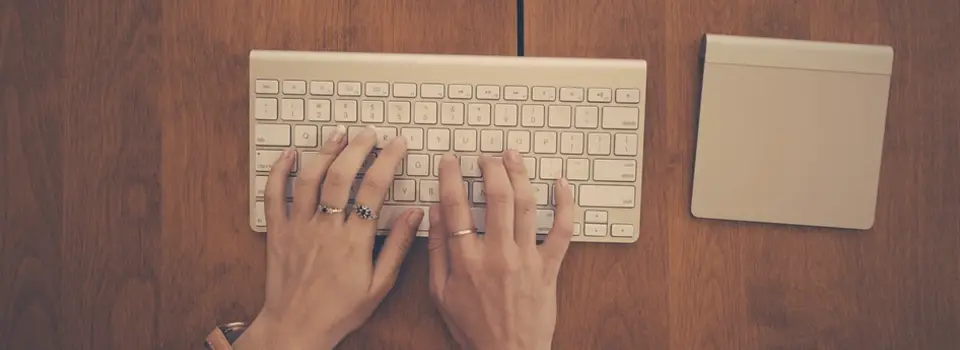Many languages use accents and diacritic marks to change how a letter or vowel sounds. If you find yourself regularly needing to type accented words, or are bi-lingual and switch between multiple languages, then knowing some shortcuts for typing accented characters can save you a tonne of time.
In this article, I’m going to share several methods of typing a wide range of special characters, including a way to change your entire keyboard layout, with the click of a mouse.
Accessing the Accented Character Menu
The quickest way to type an accented character on your Mac, is to hold down the key that most closely resembles the accented character you have in mind. For example, if you wanted to type ë then you should hold down the ‘e’ key, and after a few moments a menu will appear containing all the accented versions of this particular character.

To type any of the characters from this menu, simply give it a click or type the number being displayed directly beneath that character.
To exit the menu without selecting a character, press the ‘Escape’ key on your keyboard.
If you hold down a key and the accented menu doesn’t appear, then this may mean that there’s no accented character associated with this particular key, or that the accented menu isn’t supported in the current environment. Although the vast majority of apps, browsers and web pages support the accented character menu, occasionally you’ll encounter an environment that doesn’t, for example Google Docs doesn’t support this menu.
It’s also possible that you may have key repeat enabled on your Mac. The key repeat option overrides the accented character menu, so if you hold down the ‘a’ key you’ll wind up with aaaaaaaa rather than à.
To check whether key repeat is enabled on your Mac:
- Click the ‘Apple’ icon in your Mac’s toolbar.
- Select ‘System Preferences > Keyboard.’
- Select the ‘Keyboard’ tab.
- Make sure the ‘Key Repeat’ slider is set to the ‘Off’ position.
Try pressing the key in question again, and the accent menu should appear without any problems.
Using accent key combos
Alternatively, you can type the accented version of various characters using keyboard shortcuts. All of these shortcuts require you to press ‘Option’ plus some other character, which will display a preview of the accent this particular key combo creates.
Finally, press the key that most closely resembles the accented character you want to type.
These key combos can be tricky at first, especially since they feel like a strange keyboard shortcut that’s divided into two distinct parts, but once you’ve been using them for a while they’ll start to feel more natural.
Depending on the accented character you want to create, you can use the following key combos:
- Acute accent ( ´ ) Hold down the ‘Option’ key while pressing the ‘e’ key. Once the accent has appeared, release these keys and then press the key that most closely resembles the character you want to type.
- Grave accent ( ` ) Hold down the ‘Option’ key while pressing the ` key, then press the character you want to type.
- Chevron-shaped circumflex accent ( ˆ ) Hold down the ‘Option’ key while pressing the ‘i’ key, then press the character you want to type.
- Tilde accent (~) Hold down the ‘Option’ key while pressing ‘n,’ then press the character you want to type.
- Tréma accent ( ¨ ) Hold down the ‘Option’ key while pressing ‘u,’ then press the character you want to type.
- Cedilla accent ( ¸ ) Hold down the ‘Option’ key while pressing ‘c,’ then press the character you want to type.
You can also type the following characters, with or without ‘Caps Lock’ enabled:
- å or Å. Hold down the ‘Option’ key while pressing ‘a.’
- ø or Ø. Hold down the ‘Option’ key while pressing ‘o.’
- Æ Ligature. Hold down the ‘Option’ key while pressing the ‘ key.
- OE Ligature. Hold down the ‘Option’ key while pressing ‘q.’
Quickly switch between international keyboards
Finally, if you find yourself typing in different languages on a regular basis, then it may be easier to simply switch between different keyboard layouts that are optimized for these different languages.
macOS actually has an ‘Input menu’ icon that you can add to your Mac’s menu bar, that allows you to switch between entirely different keyboard layouts with ease.

To add this icon:
- Navigate to ‘System preferences > Keyboard.’
- Select the ‘Input sources’ tab.
- Click the little ‘+’ icon, and then add all the keyboard layouts you want to be able to switch between.
- Select the ‘Show Input menu in menu bar’ checkbox.
A new icon should appear in your Mac’s menu bar, displaying the flag of your currently-selected keyboard layout. To switch to a new keyboard layout, simply click this icon, and select the desired layout from the dropdown menu.
Before you go
After spending over 20 years working with Macs, both old and new, theres a tool I think would be useful to every Mac owner who is experiencing performance issues.
CleanMyMac is highest rated all-round cleaning app for the Mac, it can quickly diagnose and solve a whole plethora of common (but sometimes tedious to fix) issues at the click of a button. It also just happens to resolve many of the issues covered in the speed up section of this site, so Download CleanMyMac to get your Mac back up to speed today.







Add Comment